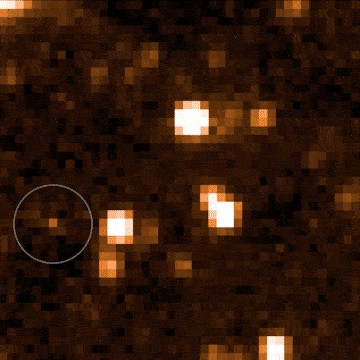American scientists detected a special brown dwarf within the galaxy, which is not a star or a planet but has a particular brightness and other characteristics of its own
Scientists and astronomers dedicated to the observation of the cosmos have tools available today increasingly powerful and precise to detect objects millions of light-years.
In addition to discovering new stars and exoplanets that orbit them, the researchers also scan space for other curious objects, such as brown dwarfs. For example, a new study offers a complete explanation of how a peculiar cosmic object called WISEA J153429.75-104303.3, nicknamed “The Accident”, came about.
The Accident is a kind of brown dwarf. Though they form in the same way as stars, these objects lack the mass required to initiate nuclear fusion, the process that allows stars to light. While brown dwarfs can be difficult to characterise at times, astronomers have a decent understanding of their overall properties.
Or they did until they came across this one.
The Accident earned its name after it was discovered by chance. It escaped detection because it bears no resemblance to any of the nearly 2,000 brown dwarfs discovered so far in our galaxy.
Brown dwarfs cool down as they age, and their brightness in different wavelengths of light fluctuates. It’s similar to how some metals cool from bright white to deep red after being heated. Scientists were perplexed by the Accident because it was dim in some crucial wavelengths, indicating it was very cold (and old), but bright in others, indicating a higher temperature.
“This object defied all our expectations,” said Davy Kirkpatrick, an astrophysicist at IPAC at Caltech in Pasadena, California.

In their latest study, published in the Astrophysical Journal Letters, he and his co-authors speculate that The Accident might be 10 billion to 13 billion years old – at least twice the median age of other known brown dwarfs. That suggests it formed when our galaxy was much younger and had a different chemical composition. If this is the true, there are most certainly many more of these ancient brown dwarfs hiding in our galaxy’s vicinity.
The Near-Earth Object Wide-Field Infrared Survey Explorer (NEOWISE), deployed in 2009 under the title WISE and overseen by NASA’s Jet Propulsion Laboratory in Southern California, was the first to observe the accident. Brown dwarfs emit predominantly infrared light, or wavelengths longer than what the human eye can see, because they are relatively cool objects.
The scientists required more information to figure out how The Accident could have such seemingly conflicting features — some indicating it is very cold, while others indicate it is much warmer. They observed it in additional infrared wavelengths using a ground-based telescope at Hawaii’s W. M. Keck Observatory. However, the brown dwarf was so dim in those wavelengths that they couldn’t detect it at all, supporting their suspicion that it was extremely cold.
They then went out to see if the dimness was caused by The Accident being farther away from Earth than expected. According to exact distance measurements taken by NASA’s Hubble and Spitzer Space Telescopes, this was not the case. After determining the object’s distance – approximately 50 light-years from Earth – the scientists discovered that it is travelling quickly – almost half a million miles per hour (800,000 kph). That is significantly quicker than all other brown dwarfs known to exist at this distance from Earth, implying that it has most likely been careening across the galaxy for a long time, colliding with huge objects whose gravity accelerates it.
With a mountain of data indicating that The Accident is incredibly old, the researchers claim that its unusual traits aren’t that strange after all, and may be a hint to its age.
The Milky Way was almost entirely made of hydrogen and helium when it began some 13.6 billion years ago. Other elements, such as carbon, originated within stars; when the most massive stars exploded as supernovae, the elements were dispersed throughout the galaxy.
Methane, which is composed of hydrogen and carbon, is abundant in most brown dwarfs with temperatures similar to The Accident. The Accident, on the other hand, has a low methane content based on its light profile. Because methane, like all hydrocarbons, absorbs specific wavelengths of light, a methane-rich brown dwarf would be dark in those wavelengths. The Accident, on the other hand, appears bright in those wavelengths, which could imply low methane levels.
As a result, The Accident’s light profile may resemble that of a very old brown dwarf that originated when the galaxy was still carbon impoverished; very little carbon at formation equals very little methane in its atmosphere today.
“It’s not a surprise to find a brown dwarf this old, but it is a surprise to find one in our backyard,” said Federico Marocco, an astrophysicist at IPAC at Caltech who led the new observations using the Keck and Hubble telescopes.
“We expected that brown dwarfs this old exist, but we also expected them to be incredibly rare. The chance of finding one so close to the solar system could be a lucky coincidence, or it tells us that they’re more common than we thought.”
To uncover more old brown dwarfs like The Accident – if they exist – researchers may need to adjust the way they look for these objects.
Dan Caselden, a citizen scientist, discovered the Accident while searching for brown dwarfs in NEOWISE data with an internet tool he created. The sky is filled with objects that emit infrared light; due to their immense distance from Earth, these objects appear to remain fixed in the sky. However, because brown dwarfs are so dim, they are only visible when they are relatively close to Earth, allowing scientists to track their movement across the sky over months or years. (Approximately every six months, NEOWISE maps the entire sky.)
Caselden’s algorithm aimed to exclude immobile infrared objects (such as faraway stars) from the NEOWISE maps in order to emphasise moving objects that resembled known brown dwarfs. He was looking at one of these brown dwarf candidates when he noticed another, much fainter object travelling across the screen swiftly. This was WISEA J153429.75-104303.3, which had not been highlighted since it did not fit the program’s profile of a brown dwarf. Caselden caught it by chance.
“This discovery is telling us that there’s more variety in brown dwarf compositions than we’ve seen so far,” said Kirkpatrick.
“There are likely more weird ones out there, and we need to think about how to look for them.”
